Make your own Choclate
Making your own chocolate is easier than you might think, you just need a few ingredients and can flavor it exactly how you want!
If you also choose organically grown, locally produced and fair trade labeled products, you are making good choices for both people and the environment!
Ingredients & Instructions
1 dl organic fairtrade coconut oil
1/2 dl honey, preferably locally produced
Gently heat over low heat while stirring continuously.
Then add:
2 dl (80 g) organic fairtrade cocoa powder
1 pinch vanilla powder (vanillin)
Keep stirring.
Flavorings (to taste):
- 1 dl hulled hemp seeds (preferably Swedish-grown)
- 1 dl organic fairtrade raisins
- 1 dl organic fairtrade and/or Swedish-grown pumpkin seeds
- Flaky sea salt
- Chili flakes
How to make it:
- Heat the coconut oil and honey gently on the stove while stirring.
- Add cocoa powder and continue to stir until smooth.
- Stir in your flavorings – hemp seeds, raisins, pumpkin seeds, salt, and chili flakes.
- Pour the mixture onto a flat tray or serving plate lined with parchment paper.
- Use a spatula to spread it out into a thin layer.
- Place in the freezer for about 2 hours.
- When ready to serve, break into smaller pieces, enjoy and share.
Want to try different flavors? Go for it – for example, with local freeze-dried berries!
Hemp products are examples of plant-based foods with exceptionally high mineral ash content, which makes them nutrient-dense additions to foods like bread, smoothies, or porridge.
Swapping wheat flour for hemp flour – even just a little – is a smart way to lower your food’s environmental footprint. It uses less water, needs fewer chemicals, helps restore soil health, and packs in more nutrients per scoop
Nutritional Comparison: Replacing 1 dl Wheat Flour → 1 dl Hemp Flour
Volume:
- 1 dl wheat flour weighs approx. 60 g
- 1 dl hemp flour (from hulled seeds) weighs approx. 40–45 g (depending on fat and fiber content)
Macronutrients (per 1 dl):
| Nutrient | Wheat Flour (1 dl, 60 g) | Hemp Flour (1 dl, 45 g) | Difference |
|---|---|---|---|
| Energy | ~200 kcal | ~250 kcal | +50 kcal |
| Protein | ~5.8 g | ~14.2 g | +145% |
| Fat | ~1.2 g | ~13.0 g | >10x higher |
| – Saturated Fat | ~0.1 g | ~1.2 g | Higher |
| – Omega‑3 | ~0 | ~2.5–3 g | Much higher |
| Carbohydrates | ~45 g | ~4–6 g | Much lower |
| – Fiber | ~7.8 g | ~5–12 g | Varies |
Micronutrients (approximate values):
| Nutrient | Wheat Flour (1 dl) | Hemp Flour (1 dl) | Comment |
|---|---|---|---|
| Iron | ~2.2 mg | ~3.6 mg | +65% |
| Zinc | ~2.8 mg | ~12–15 mg | +400–500% |
| Magnesium | ~80 mg | ~150–250 mg | Higher |
| Potassium | ~235 mg | ~500–600 mg | Higher |
| Vitamin B1 | ~0.18 mg | ~0.6 mg | Higher |
| Folate (B9) | ~17 µg | ~50–60 µg | Higher |
Summary of Effects:
By replacing 1 dl of wheat flour with 1 dl of hemp flour in bread, you get:
- More than twice the protein, which supports satiety and muscle repair.
- Significantly more healthy fats, especially well-balanced omega-3 and omega-6.
- Substantially higher levels of minerals, especially iron, zinc, magnesium, and potassium.
- Lower carbohydrate content, which can be beneficial for low-carb diets.
- Slightly less fiber per volume, depending on the type of hemp flour (whole seed vs. defatted).
Practical Effects in Baking:
Thanks to its high fat content, hemp flour can make baked goods more moist—but also heavier.
Hemp flour contains no gluten, which affects dough structure. Expect denser and crumblier results.
It has a nutty flavor, which can enhance or alter the taste of your recipe.


